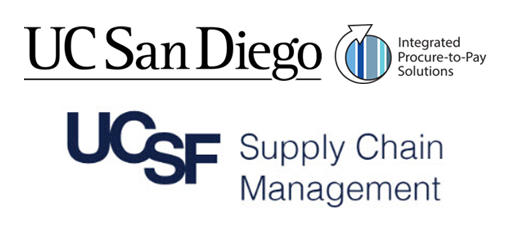By Yvonne Tevis, Chief of Staff, UCOP Information Technology Services. “Collaborating is an experiment,” said Jenn Glassman, assistant director for technology and project management in UC San Diego’s procure-to-pay organization. She speaks from experience. Glassman and Melissa Gee, UC San Francisco supply chain operations manager, are key players in the UCSD-UCSF joint implementation of two supply chain solutions, Transcepta and ProShip.
Transcepta is a SaaS provider whose solution offers low-tech suppliers an option to submit invoices directly into UCSF and UCSD’s procure-to-pay systems, helping propel the two campuses toward their goal of 100% paperless invoice processing.
ProShip is an outbound shipping technology solution that allows campus personnel to comparison shop across UPS, FedEx, and other carrier rates, accounting for UC negotiated rates and the type of materials being shipped. Depending on the material and level of risk, the system also allows for workflow routing to shipping specialists who can further review and generate appropriate documentation for the material being shipped.
Prior to the UCSD-UCSF collaboration, the two campuses’ supply chain organizations had been proactive in learning from each other, recognizing that they have similar missions and goals. “We made a point of knowing our peers at the other schools,” said Gisella Higgins, director of logistics at UC San Diego and ProShip co-sponsor. “Our campuses are dealing with the same processes and challenges.”
That relationship smoothed the way for collaboration, which isn’t always easy. Vanessa Wong, director of supply chain solutions & procurement at UCSF said, “Ultimately, you still have two individual campuses with unique challenges, a different campus culture and user expectations, and a different financial system.”
Glassman agreed. “We learned that if we were going to succeed in delivering a meaningful solution to each of our campuses, we were going to have to figure out how to disagree, how to manage our differences, and how to work within a common framework rather than an identical process,” she said.
Why collaborate if each campus could go its own way with potentially less upfront time and effort? Glassman said, “It’s balancing the short-term needs with the long-term gain. So many times in our mutual pasts, we found that we had independently developed solutions to meet very similar business needs. Then we’d look at each other and think, ‘Why’d we build two of the same thing?’”
While most of the ROI for these two solutions is fulfilled as more campuses are able to come onboard, both campuses experienced upfront efficiencies: Collaborating campuses pay for only one project manager, split the SaaS provider implementation and licensing costs, and pool their subject matter expertise.
The sharing continues post implementation, too. Gee said, “When we encounter issues, it’s nice to have a campus that knows what’s going on and to ask them for advice.” Indeed, that desire to not reinvent the wheel was a major driver behind the collaboration.
UCSD and UCSF summarized tips for pursuing successful collaborations:
- Identify and reach out to your campus peers to find out if you’re focusing on similar priorities.
- Look for the right opportunity. It can be easier to standardize a process when launching a new application and more complex to standardize using existing systems.
- Allow for more planning time upfront to learn about each organization’s challenges and business limitations.
- Figure out if you want to normalize a process, generally align a process, or publish best practices.
- Make sure your central IT groups are in on the collaboration early, especially if there are system integrations at play.
- Leverage UCOP to see how it can support the business challenge you are trying to solve.
Both programs are continuing to evolve and are open for adoption by other campuses. Berkeley is leveraging the same Transcepta platform, and UC Davis is exploring the possibility of using the ProShip instance, once the UCSF/UCSD implementation is complete.
Glassman said, “Collaboration is not the easiest thing in the world, so the takeaway for us was to find and develop campus relationships where we could jointly align our strategy; commit ourselves to the experiment; and allow the partnership to blossom.”

